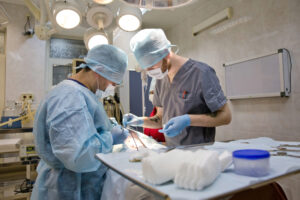
Postoperative care for your dog after orthopedic surgery is critical for recovery, so always ask any questions you have to ensure the comfort of both you and your companion.
Surgery is a big deal for both humans and animals, and postoperative care is a critical component of ensuring the success of the surgery and avoiding any secondary issues. Managing pain, avoiding infections, and minimizing trauma are all important factors that need to be considered when handling postoperative care for your dog after orthopedic surgery.
Communication
Be sure to listen to your veterinarian’s postoperative instructions closely when you go to pick up your companion. Ask any questions you have about any of the aftercare procedures they discuss and demonstrate for you. Ensuring you understand the process and what the best methods are will make it easier for you and your dog during postoperative care. If you have a question or concern that comes up after you have left your vet, call them for advice. Your veterinarian’s office will be happy to help you troubleshoot any issues you might have so that your dog can heal properly.
Medication
Following your dog’s procedure, they will likely be on several medications to reduce pain, and inflammation, as well as fight off potential infection. These medications are critical to ensuring your companion’s full recovery as quickly as possible. As always, be sure to ask any questions you have regarding the instructions, how to administer these medications, and what they’re for if you’re unsure. Set alarms so that you are always on schedule with your dog’s medication and you never miss a dose. It is important to finish all medications as directed and report any adverse effects such as vomiting or diarrhea.
Site Care
The requirements for the care of a wound site vary depending on the procedure your dog has undergone. Incision sites that are able to be left without a bandage need to be monitored for signs of infection and kept clean. Some procedures will require wrap and bandage changes, which should be completed by veterinary staff at the recommended appointment. In both cases, an e-collar will be given to obstruct the dog from tampering with the wound.
Activity
After orthopedic surgery, it will be important to limit your dog’s activity. Dogs are resilient, especially young dogs, so a few days of recovery and some painkillers can result in a desire to resume their normal activities. This can be one of the most difficult trials for an owner because the point of the surgery was to get them back on their feet. Orthopedic surgeries can take several weeks to several months to fully heal, and it is critical that activity restrictions are followed for the best possible results. A failure to properly restrict the dog’s activity could result in trauma to the surgery site that prolongs the healing time or requires another surgery to repair.
Trust Maryland Veterinary Surgical Services With Your Companion’s Health
Your companion’s health is important, and the team at MVSS is ready to provide the best care possible for your furry family. We are dedicated to combining comprehensive exams and assessments with informative and honest discussions of your companion’s care. Once we have worked with you to decide on the best course of action for your dog, our professionals will use their surgical expertise to work towards the goal of giving your companion an active and pain-free life. We are proud to serve loyal companions in Catonsville and Baltimore. To learn more about our services, give us a call at 410-788-4088 or visit us online. For more information and tips for pet health, follow us on Facebook and Pinterest.
